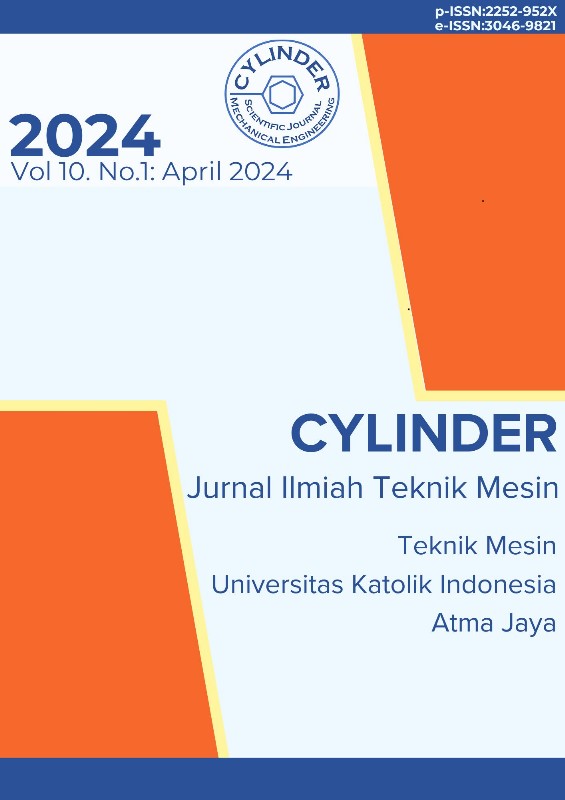Analytical Simulation of Linear Comparison of Temperature Changes Versus Time in the Heat Equilibrium Process of Mixing Two Liquids
DOI:
https://doi.org/10.25170/cylinder.v10i1.5473Keywords:
Entropy; Thermodynamics; Temperature; Heat Equilibrium.Abstract
The explanation of the concept of entropy which explains that the increase in disorder in a closed system that works in advancing time comes from the second Law of Thermodynamics. In its development, Law of Thermodynamics 2 was enriched by the presence of Law of Thermodynamics 2.1 which states that the average entropy process in the forward direction will be the same or smaller than in the backward direction. The meaning of the entropy averaging process in the backward direction is that the entropy averaging process is in the forward direction but works on a heat function that mirrors the previous one, namely the heat function over time in the forward direction. Furthermore, by utilizing the Law of Thermodynamics 2.1, the results of analytical simulations can be seen comparing the level of linearity of changes in temperature over time in the process of heat flow towards thermal equilibrium in the mixing of two liquids. The results of this analytical comparison show one of the benefits of developing the second Law of Thermodynamics, namely Law of Thermodynamics 2.1.
References
Goenawan, Stephanus Ivan, Comparison Simulation Analysis Of The Gradual Summation Of A Function With Recognition Of Direct Extrapolation Via In Series, IJASST Univ. Sanata Dharma, Yogyakarta, 2020. https://www.e-journal. usd.ac.id/index.php/IJASST/article/view/19 69/0,
Goenawan, Stephanus Ivan. Hukum Entropy Goen / Termodinamika 2.1 Rerata Entropy Sistem Arah Maju Berbeda Dengan Arah Mundur Berguna Dalam Fisika Termodinamika, HKI 2022.
Goenawan, Stephanus Ivan. 2023. The Law Of Thermodynamics 2.1 Average Entropy In The Forward Direction Smaller Than The Backward Explaining The Direction Of Forward Time, International Conference on Informatics, Mechanical, Industrial and Chemical Engineering (ICIMICE 2023)
Ziegler, H. An Introduction to Thermo-mechanics. North Holland, Amsterdam, 1983.
Kleidon, A., Ralph D. Lorenz. Non-equilibrium Thermodynamics and the Production of Entropy. Heidelberg: Springer 2005.
David A. Freedman. Statistical Models: Theory and Practice. Cambridge University Press. 2009. ISBN 978-1-139-47731-4.
Lavenda. Bernard H, A new perspective on thermodynamics, New York: Springer, 2010, ISBN 978-1-4419-1430-9.
Lang. Serge, Calculus of several vari-ables (3rd ed.), Berlin, DE; New York, NY: Springer-Verlag, ISBN 978-0-387-96405-8 (1987).
Martyushev. L. M. and Seleznev. V. D, "The restrictions of the maximum entropy production principle", Physica A: Statistical Mechanics and Its Applications. 410 (2014).
Moran. Michael J, and Howard. N Shapiro, Fundamentals of Engineering Thermo-dynamics, 6th ed, Wiley and Sons: 16 (2008).
R. Giles, Mathematical Foundations of Thermodynamics: International Series of Monographs on Pure and Applied Math-ematics, Elsevier Science, ISBN 978-1-4831-8491-3 (2016).
Sethna. James, Statistical mechanics : en-tropy, order parameters, and complexity. Oxford University Press. p. 78. ISBN 978-0-19-856677-9 (2006).
Saha. Arnab, Lahiri. Sourabh and A.M. Jayannavar, "Entropy production theorems and some consequences", Physical Review E. 80 (2009).
Sachidananda. Kangovi, "The law of Dis-order," ISBN 9798677301285, Amazon Publishing (2020).
M. Srednicki, "Entropy and area," Phys. Rev. Lett. 71 (5): 666–669 (1993).
Downloads
Published
How to Cite
License
Copyright (c) 2024 Cylinder : Jurnal Ilmiah Teknik Mesin

This work is licensed under a Creative Commons Attribution 4.0 International License.

